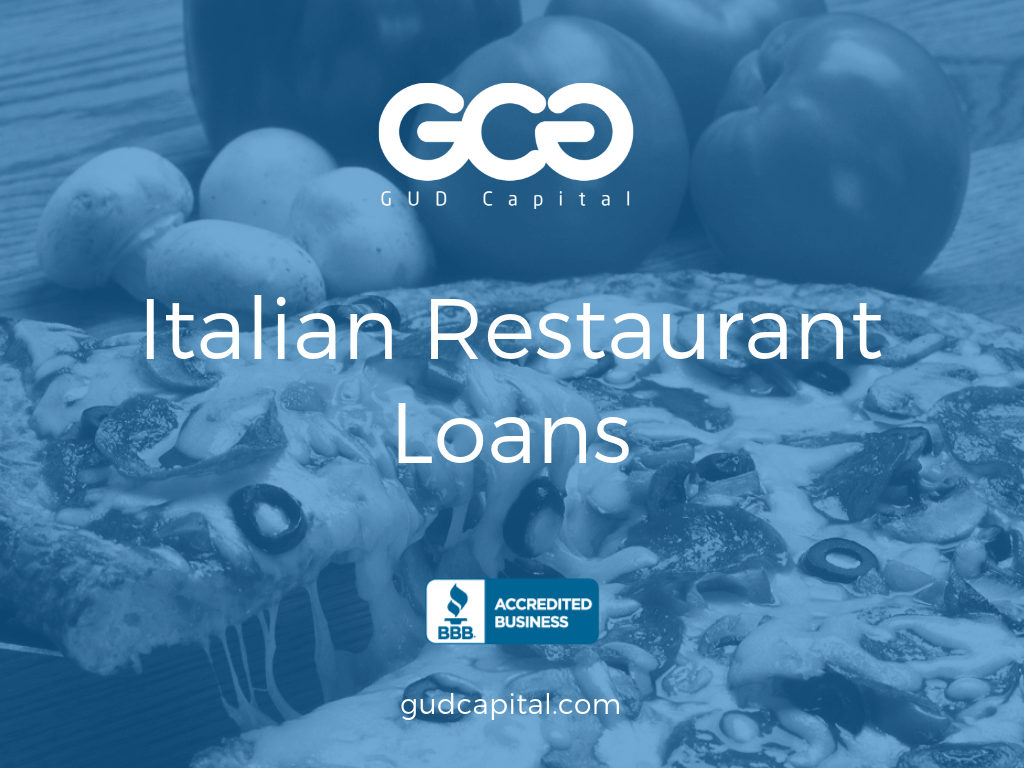Italian Restaurant Business Financing
When we think of Italian restaurants, what usually comes to mind is pasta, meatballs, and pizza. Especially from the perspective of Americans, this reigns true; Italian cuisine ranks as number three just below Mexican and Chinese as an American favorite. Italian cuisine can be characterized by its simplicity, as many of their dishes have only two to four main ingredients and Italian cooks tend to rely heavily on the quality of the ingredients rather than on excellent preparation; and depending on the region, dishes can vary. It is a cuisine which has become popular and widely adopted all over the world. Most notably famous are southern and northern Italian cuisine. In the north, Milan is known for their risottos, and the south such as Naples is renowned for its pizzas and spaghetti. However, with tradition put aside American Italian restaurants have created a ‘New’ Italian that spotlights ingredients and techniques that have been taking classic Italian dishes to new heights. Additionally, the modern Italian food influence is happening as over half of Italian food lovers say they seek out specific regional Italian cuisines such as Tuscan from Northern Italy or Sicilian from Southern Italy. Therefore, many new developments are taking hold of the Italian restaurant industry that is sure to offer up delicious new recipes as well as evolving business practices.
Quick-jump to the following sections:
- Bank Term Loans
- Secured Line of Credit
- Unsecured Line of Credit
- SBA Loans
- Equipment financing
- Alternative Loans
- Cash Advance
One notable business development for Italian cuisine that has also impacted other restaurants to do the same are healthier alternatives. Buying food with clean and clear labels is slowly becoming the new international standard and restaurants are putting in a considerable effort to make it a smooth transition. In this regard, Italian establishments are simplifying recipes, using fewer ingredients, and clean labels. Additionally, vegetables in recipes have increased 25% over the last year with the launch of more vegetarian/vegan options. We are also seeing sugar substitutes being used more often such as stevia that has increased 28% between 2012 and 2018 and the majority of Italy products are becoming low sugar. Lastly, seeds are being used more like chia and quinoa to suggest further consumers are eager for healthier options.
Another observation that can be seen in the Italian restaurant industry is how it has managed to not become like a chipotle, salad bars, bakeries, or burger joints. The absence of significant fast-casual Italian food chains is not for lack of success but complication. American-style Italian food has everything to do with food texture and the tradition of gathering around a table and breaking bread with friends and relatives. Hence, that idea is not precisely transferable to a model that has people rushing through a cafeteria-style, choose-your-topping line before hurrying back to work to engulf their food at a desk. Moreover, then we have the issue of quality. Soggy and brittle pasta is obviously not desirable, therefore finding the perfect consistency for noodles while operating within a tiny window of cook time to achieve the right texture can be difficult. However, the chain known as Vapiano, a relatively small German-based company that has 12 locations across North America and dozens in Europe have found a way to operate closely to Chipotle-level speed and quality while also managing a finicky spaghetti noodle. The serving time is slightly longer than Chipotle and a bit more expensive. Additionally, we have chefs such as Mark Ladner who have ideas to offer his customers a service called Pasta Flyer, where they will be able to choose between three different types of cooked-to-order pasta—rigatoni, fusilli, and penne with several sauces. There will also be a variety of none-pasta meal items available. Ladner is shooting for each customer to get through the line and with their food in under three minutes.
Moreover, Italian food and restaurants have many insightful and fun facts found in American and traditional Italian cooking that has contributed to its popularity and making it one of the most sought after cuisines. Such as, there are more than 600 pasta shapes produced worldwide, and the average person in Italy eats more than 51 pounds of pasta every year; while the average person in North America consumes about 15-1/2 pounds per year. Furthermore, each region in Italy has its favorite ways to eat pasta. In Rome, two classics are the carbonara (with eggs and bacon) and the cacao e pepe (with cheese and pepper). Also, most Americans cannot imagine not eating meatballs with spaghetti, yet native Italians do not put meatballs on spaghetti, and the average Italian meal is divided into two parts, primo piatto, and secondo piatto. Also, it was not until the 1700’s that tomato sauce was included with spaghetti in Italian kitchens. Thus, with everything discussed from business developments to fun facts, It is clear to see Italian restaurants continue to be a lucrative cuisine loved by people all over the world as culture mixed with curiosity have made it into what it is today.

Types of Italian Restaurant Loans
Restaurants need working capital from time-to-time. Common uses of funding are to acquire an existing Italian restaurant business, hiring employees, making restaurant payroll on time, upgrading and replacing the restaurant’s equipment, paying food suppliers, as well as emergency uses. Below we will take a look at the most common restaurant funding options, to help you figure out the restaurant loan that’s best for you.
Bank Loans
Banks offer the most affordable financing products for Italian cuisine restaurants through both term loans and lines of credit. A bank term loan has rates in the mid-single digits, and can have terms up to 30 years depending upon use. Italian cuisine restaurants that are seeking bank loans can expect to have their credit scrutinized, as well as the company’s financials. If the owner of the Italian cuisine restaurant have very good credit, and the business shows profitability year-over-year, there is a good chance they could qualify for a bank loan.
| Rates | 5-15% |
|---|---|
| Terms | 1-25 years |
| Funding Amounts | $50,000-$5,000,000 |
| Collateral | Required |
| Fees | Medium costs |
Secured Line of Credit
A line of credit is an excellent financing product for not only Italian cuisine restaurants, but all small businesses. A line of credit is different from a term loan in the fact that amount the business qualifies for doesn’t have to be taken all at once but, instead, in smaller increments as its needed by the Italian cuisine restaurant. This allows the restaurant to only pay interest on the funds that are drawn – not on the overall amount the restaurant has qualified for.
| Rates | 5-15% |
|---|---|
| Terms | 1-2 years |
| Funding Amounts | $10,000-$5,000,000 |
| Collateral | A/R Required |
| Fees | Medium costs |
Unsecured Line of Credit
An unsecured line of credit for Italian cuisine restaurants works just like a bank line of credit – in that the borrower can draw on funds as needed, and only needs to pay interest on the amount that is drawn (not the overall amount they’ve been approved for). The difference with an restaurant unsecured line of credit is that it doesn’t require business collateral to get approved. This type of funding is almost solely-based upon the Italian restaurant owner’s credit, so an excellent credit score is required.
| Rates | 0% for 12 months |
|---|---|
| Terms | 1-2 years |
| Funding Amounts | $10,000-$500,000 |
| Collateral | Not be Required |
| Fees | Medium costs |
SBA Loans
One of the most common forms of conventional financing products used by Italian cuisine restaurants are SBA loans. Restaurant SBA loans are conventional business loans offered by traditional business lenders. What makes an Italian restaurant SBA loan different is that the U.S. Small Business Administration agrees to cover a large portion of the lender’s exposure in case the restaurant defaults on the loan. By offering this “guarantee” to the lenders, the U.S. Small Business Administration encourages these lenders to provide loans to small businesses they normally wouldn’t lend to.
| Rates | 5-8% |
|---|---|
| Terms | 3-25 years |
| Funding Amounts | $50,000-$5,000,000 |
| Collateral | Required |
| Fees | Medium costs |
Equipment Financing
Italian restaurants use plenty of equipment. Whether its ovens, ranges, stoves, dishwashers, HVACS, they need equipment to run their restaurant’s properly. While getting a loan to purchase such restaurant equipment is an option, another way to acquire equipment is to lease. Equipment leasing for Italian restaurants is a great way for restaurants to get crucial equipment, without having to purchase the equipment outright. By leasing the equipment, the restaurant only needs to put a fraction of the equipment’s costs as a down payment, and will have the option to purchase the equipment at the end of the term.
| Rates | 8-20% |
|---|---|
| Terms | 1-10 years |
| Funding Amounts | $10,000-$5,000,000 |
| Collateral | Required |
| Fees | Medium costs |
Alternative Loans
Alternative Italian restaurant loans are an option for borrowers who don’t qualify for bank financing, but still have good enough credit and cash flow to support a quality business loan. While alternative business loans don’t have rates that are in the low single digits, they do offer rates that are affordable for working capital purposes.
| Rates | 8-25% |
|---|---|
| Terms | 1-5 years |
| Funding Amounts | $10,000-$500,000 |
| Collateral | Not required |
| Fees | Medium costs |
Cash Advance
An Italian restaurant cash advance is a common financing product used for short-term uses. A cash advance isn’t actually a loan provided to the restaurant, but the purchase of future bank deposits or credit card transactions the restaurant will make in the future. In return for immediate lump sum funding, the restaurant agrees to sell some of their future receivables to a funder at a discount. Another advantage of restaurant cash advances is that credit isn’t very important, and this type of funding is almost solely based on the restaurant’s cash flow.
| Factor rates | 1.10 – 1.50 |
|---|---|
| Terms | 3-24 months |
| Funding Amounts | $5,000-$2,000,000 |
| Collateral | Not required |
| Fees | Low to High costs |
Summary
Italian restaurants do not lack funding options — especially for working capital. These are just a few of the various financing products for Italian restaurants. The key is getting the financing product that is the best fit while offering the best rates and longest terms for your restaurant. If you are an owner of an Italian cuisine restaurant and looking for financing, please feel free to reach-out to one of our funding specialists, and we’ll help you navigate the process.
[wp-review id=”100570″]





















